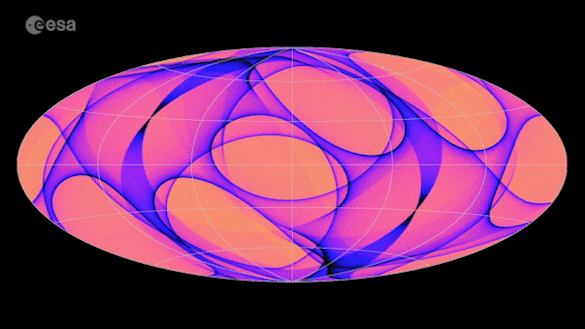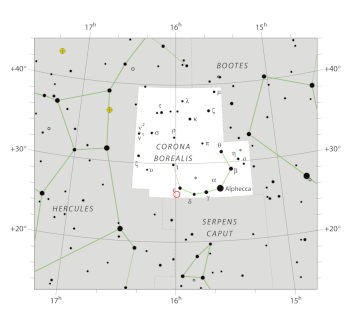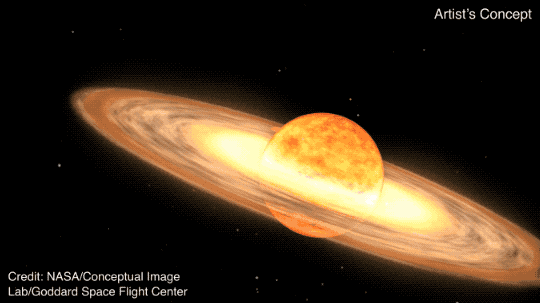T Coronae Borealis
April 1, 2024
There are about a quarter of a million
stars within 250
light years of
Earth, most visible to
space observatories such as the
European Space Agency's Gaia. The space observatory, Gaia, which I wrote about in a
previous article (Gaia Asteroid Census, August 8, 2022), can detect stars brighter than
apparent magnitude 20 in a
wavelength range of 320-1000
nanometers; that is, from
near ultraviolet light, through the
visible spectrum, and including short wavelength
infrared light.

This is a visualization of Gaia's sky coverage. It would make a pleasant wallpaper image for a cellphone or tablet computer. (A still frame from a Wikimedia Commons animated image by B. Holl of the University of Geneva, Switzerland, and A. Moitinho and M. Barros of CENTRA, University of Lisbon.)
Before
telescopes,
ancient astronomers had only their
unassisted eyes available for
observation, and this placed a limit on the number of visible stars. The best
human eyes can discern stars down to magnitude 6.5, and there are 9,110 such stars, as
tabulated in the
Yale Bright Star Catalog.[1] There's one star,
T Coronae Borealis, that's briefly visible to the unassisted eye. This star is a
recurrent nova in the
constellation,
Corona Borealis, and it exhibits sudden and extreme
outbursts in
luminous intensity. For T Coronae Borealis, the interval between outbursts is about 80
years, and an outburst increases its apparent magnitude from 10 to 2.5 ± 0.5.

The location of T Coronae Borealis, as circled in red.
Variable star such as this are not labeled with a Greek letter; rather, they are labeled with Latin letters R through Z. This means that T Coronae Borealis was the third discovered variable star in Coronae Borealis.
T Coronae Borealis is located at right ascension, 15h 59m 30.1622, and declination, 25° 55' 12.613", and it's 2629 light years (806 parsecs) from Earth.
(Wikimedia Commons image by the International Astronomical Union and Sky & Telescope magazine (Roger Sinnott & Rick Fienberg). Click for larger image.)
An outburst of T Coronae Borealis was first
discovered by
Irish astronomer and
polymath,
John Birmingham (1816–1884), in 1866, reaching peak magnitude of 2.0 on May 12, 1866. It had been a known star long before that time, and outbursts may have been observed in 1217 and in 1787. A subsequent outburst to magnitude 2.5 ± 0.5 was detected on February 9, 1946. The star is the
white dwarf companion of a
red giant in a nearly
circular orbit of
period 228
days at 0.54
astronomical units (AU) spacing, somewhat larger than the orbit of
Mercury around the
Sun. The red giant transfers
material to T Coronae Borealis.
T Coronae Borealis is one of 10 known recurrent novae in the
Milky Way Galaxy, and the
mechanism for its outburst is known.[4] As the white dwarf companion of a red giant, it collects
matter ejected from its unstable red giant companion.[2] This is facilitated by the white dwarf's high
mass and relatively small size that makes it
gravitationally strong.[3] Eventually, this matter infall causes a runaway
thermonuclear reaction when its
temperature reaches a few million
degrees Celsius.[2-3] Since the nova eruption involves just a small fraction of the mass of the
binary star system, this process can repeat.[4]

An artist's conception of a recurrent nova in a binary star system composed of a white dwarf and a red giant. The white dwarf is hidden in an accretion disk around the red giant, while a stream of material flows from the red giant to the white dwarf. Eventually, enough matter is captured by the white dwarf to ignite the nova. (NASA Goddard Space Flight Center animation.)
According to
NASA, the next eruption of T Coronae Borealis is expected this year. This
prediction comes not just from the
historical 80 year interval between eruptions, but by the observation that the star dims about a year before eruption.[3,5] Also detected was a
flicker of up to 0.2 magnitude on November 14, 2022, and on April 23, 2023.[4] A recent
paper in the
Monthly Notices of the Royal Astronomical Society examined the
light curve of T Coronae Borealis from 1842 to 2022 to predict an eruption at 2024.4 ± 0.3; that is, any time between now and September.[2-3,5]
At eruption, the anticipated magnitude of 2.0 will give the nova a similar brightness to
Polaris, the North Star, making it visible to the unaided eye.[2-3] The peak brightness could even be as much as that of the
planet Mars, and it is expected to remain visible to the unaided eye for a few days, and visible with
binoculars for about a week.[2-3]
References:
- Yale Bright Star Catalog, via Harvard University.
- Lauren Perkins, "View Nova Explosion, 'New' Star in Northern Crown," NASA Marshall Space Flight Center, February 27, 2024.
- Mia Taylor, "Move over, solar eclipse: Scientists predict a once-in-a-lifetime nova explosion in the coming months," BBC, March 22, 2024.
- Jeremy Shears, "Get set for the next eruption of the recurrent nova T Coronae Borealis!" British Astronomical Association, August 22, 2023.
- Bradley E. Schaefer, "The B & V light curves for recurrent nova T CrB from 1842-2022, the unique pre- and post-eruption high-states, the complex period changes, and the upcoming eruption in 2025.5 ± 1.3," Monthly Notices of the Royal Astronomical Society, Vol. 524, No. 2 (March 14,2023), pp. 3146-3165, https://doi.org/10.1093/mnras/stad735.
Linked Keywords: Star; light year; Earth; space observatory; European Space Agency; Gaia (spacecraft); apparent magnitude; wavelength; nanometer; near ultraviolet; visible spectrum; infrared light; scientific visualization; celestial sphere; sky; wallpaper (computing); mobile phone; cellphone; tablet computer; still frame; Wikimedia Commons; University of Geneva, Switzerland; CENTRA; University of Lisbon; telescope; ancient astronomer; unassisted eye; human eye; table (information); tabulated; Yale Bright Star Catalog; T Coronae Borealis; recurrent nova; constellation; Corona Borealis; explosion; outburst; luminous intensity; year; location of T Coronae Borealis; variable star; Greek alphabet; Greek letter; variable-star designation; Latin script; Latin letter; right ascension; declination; parsec; Earth; International Astronomical Union; Sky & Telescope magazine; discovery (observation); discovered; Ireland; Irish; astronomer; polymath; John Birmingham (1816–1884); white dwarf; red giant; circle; circular; orbit; frequency; period; day; astronomical units (AU); mercury (planet); Sun; material; Milky Way Galaxy; physics; mechanism; matter; coronal mass ejection; eject; mass; gravitation; gravitational; nuclear fusion; thermonuclear reaction; temperature; degrees Celsius; binary star system; artist's impression; artist's conception; accretion (astrophysics; accretion disk; fluid dynamics; flow; ignite; NASA Goddard Space Flight Center; prediction; history; historical; flicker (light); scientific literature; paper; Monthly Notices of the Royal Astronomical Society; light curve; Polaris, the North Star; planet Mars; binoculars.